Read the following passage and mark the letter A, B, C or D to indicate the correct word or phrase that best fits each of the numbered blanks from 31 to 35.
If cartoons are anything to go by, then the attitude of the British towards the family, and of British men towards the (31) ________ sex, has not changed much recently, despite attempts to shame people into admitting their prejudices. The mother-in-law, frequently of horrific (32) _______ and usually either about to visit, or being somehow driven from the house is still a favorite butt of this kind of humor. Marriage itself has been reduced to the skinny male, dominated by a massive female who habitually lies in wait with the rolling pin behind the door for the return of her drunken spouse. Children are rarely shown other than as screaming infants, or else as ill-favoured urchins who (33) _____ all their time being objectionable or asking for money. The old are simply (34) _____ as comic characters. The problem is, how do such cartoons relate to the way people truly see each other? Does a joke always contain some grain of truth, however much we may dislike to admit it? In other words, is life really a series of mother-in-law jokes? Or do jokes have a life of their own, with a (35) _______ of stereotypes we can recognize, like the Englishman with his umbrella and bowler hat, or the Frenchman with his striped jumper and beret?
Question 34
A seen
B. such
C. enough
D. notorious.


Đáp án A
Giải thích:
Seen là V(pp) của see (nhìn): Ở dạng bị động như câu này, ta nên dịch là “được coi là, nhìn như là”
such: (adj) như vậy
enough: (adj) đủ
notorious: (adj) khét tiếng
Đằng sau có as, ta có be seen/known/considered as: được coi như là